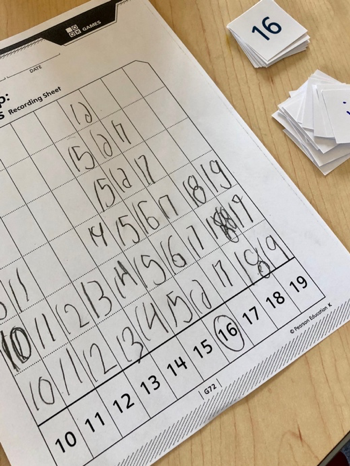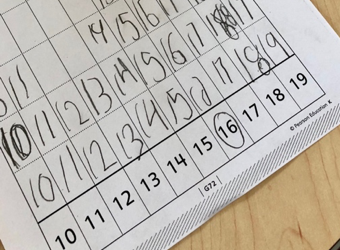Last spring, I visited a Kindergarten classroom near the end of the year. Students were participating in a Math Workshop focused on the teen numbers, choosing among activities that asked them to identify and recognize teen numbers; to represent them in several different ways (e.g. on Ten Frames, with cubes, with numerals); and, ultimately, to come to see them as being composed of ten ones and some numbers of ones.
I wandered over to Stella, who was playing Race to the Top: Teen Numbers. In this game, you turn over a teen number card, and then record that number in the appropriate column.
While this particular game is focused primarily on recognizing and writing teen numbers, Stella had worked on several other Math Workshop activities over the past several days and big ideas about the teen numbers were “in the air.” I joined her and asked what she was noticing about the game. She said:
“I don’t know why there’s so much 1s in the numbers.”
I asked her to tell me more. She pointed to the 1 in each of the numbers along the bottom of the gameboard. “That’s really interesting,” I said. “I wonder why that is?”

To my chagrin, the music signaling the end of Math Workshop began playing. Ms. T asked students to clean up and, when finished, to stand in front of their math chair. As the kids cleaned up, I told Ms. T what Stella had said. Excited, she decided to have a quick discussion, right then and there.
“I heard something really interesting that I want to tell you about. Stella was playing Race to the Top: Teen Numbers. And she noticed something really interesting. She said, ‘I don’t know why there’s so much 1s in these numbers.’”
Ms. T walked around the room with a blank gameboard, showing it to students as they stood in front of their chairs. She kept repeating Stella’s quote while pointing to the row of teen numbers along the bottom of the gameboard.
“I wonder what you think about that?”
Peter: Because 1 is a teen number.
Juan: 1 and 4 is a teen number.
Fatima: One and another number together is a teen number.
Nicole: 1 is the symbol for a teen number.
Alexa: You can’t make a teen number without a 1 in front. Because that makes it a teen number.
Ms. T went over to the class number line. She pointed to the teen numbers, saying
“Alexa is saying that all of these numbers have a 1.”
John: And they each have 2 numbers!
One child came up to the number line and pointed to the numbers, saying “One zero, one one, one two…” and another pointed to them, saying “1 comes in front of all of these numbers.”
Alexa: If you put 4 in front it would be 41. But if you put 1 in front it’s 14.
“So it sounds like where in the number, that the order of the numbers is very important…”
With this comment on Alexa’s idea, and the quiet highlighting of a very big idea, Ms. T transitioned the class to the next activity in their day. I was left thinking about so many different things after one short classroom visit.
- Stella’s experience choosing among several related math activities and games, over several days, had contributed to her important mathematical wondering. Math Workshop is a powerful structure.
- In this community, students are working to make sense of ideas, to ask their own questions, and to genuinely take up the ideas of others. This vignette speaks to me about what mathematical identity and agency look like when you are 5 or 6 years old.
- I was also marveling at the teacher decision-making and skill on display in such a short time, and how subtle some of it was. For example:
- A discussion doesn’t have to be a long, planned-for, come-to-the-rug production. It can be 5 minutes while students stand in front of their chairs.
- A discussion can highlight an important math idea by sharing a student’s observation for others to think about and comment on. It can also position that child as a maker of important mathematical observations, ideas that are worth taking up as a class.
- 8 students shared an idea over the course of 5 minutes, with almost no interruption from the teacher. She didn’t speak after each child or rephrase and amplify the idea she was hoping to hear. What she did do was point kids to a tool where they could see the ideas being discussed, and restate Alexa’s big idea as something to be thinking and wondering about. It is clear that, in this classroom, there is time and space for students to linger on important ideas over time, and that students are eager to do so.
- Developing Classroom Agreements in the Investigations 3 Classroom - October 25, 2021
- Meaningful Math Discussions: It’s about the Ideas, Not Where You Discuss Them - April 12, 2021
- Teaching Investigations 3 Remotely: Not So Different - February 22, 2021


Thank you for posting this image from a kindergarten classroom. It’s a powerful reminder of what happens when we give learners, of any age, the opportunity, the space, and the time to explore while actively listening to them and attending to what they are noticing. It also reminds me of how a simple discussion can highlight a mathematical idea as the students and teacher interact with each other and with the task. These reminders are a great way to start my Monday!
Your comment isn’t a bad way to start my Monday! Thanks for posting it.